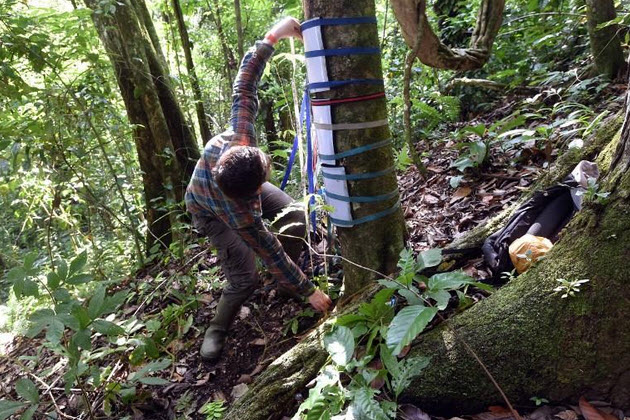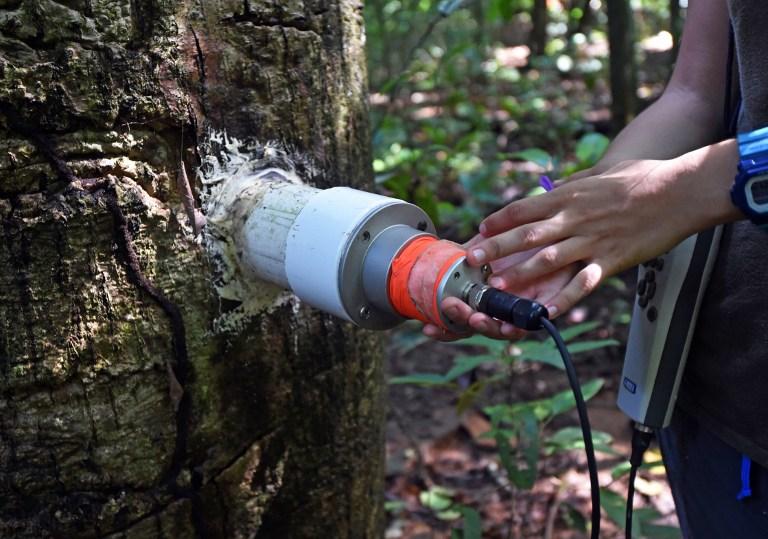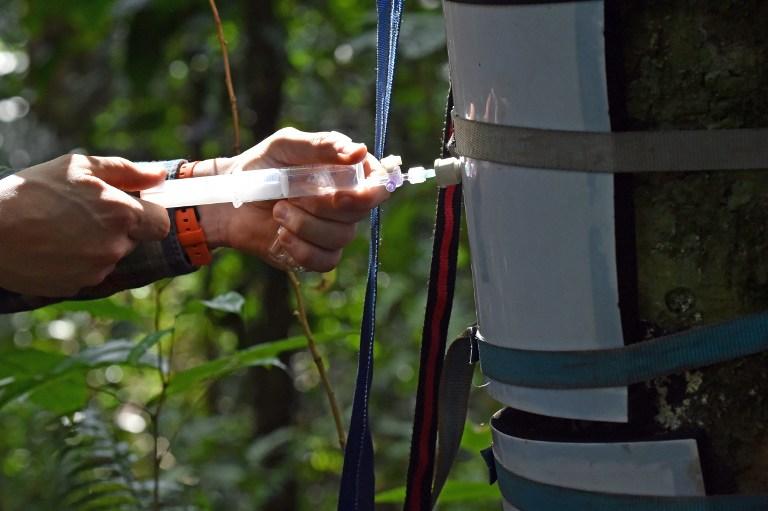Barro Colorado Island is 15.6 square kilometers (six square miles), roughly four times the size of New York’s Central Park.
Located in Gatun Lake, created in the early 20th century, it is run by the Smithsonian Tropical Research Institute and currently boasts 350 scientific projects under way, by scientists from around the world.
“Barro Colorado is probably the most studied tropical forest in the world. It has given us many ideas about how forests work in other parts of the world,” William Laurance, an associate STRI researcher and Australian professor in tropical conservation, told AFP.
“If somebody asks what is the Mecca for researching tropical biology, I answer Barro Colorado,” added Camilo Zalamea, a Colombian biologist and botanist who trained in France.
Colombian scientist Camilo Zalamea works in his project “Seed defense syndromes of tropical forest trees: emergent properties of seed dormancy, defense and microbial interactions” in Barro Colorodo island, in the artificial Gatun Lake of the Panama Canal on November 23, 2015. The island was declared a nature reserve on April 17, 1923 by the U.S. government. It was initially administered by the Panama Canal Company, and since 1946 it has been administered by the Smithsonian Tropical Research Institute, forming the Barro Colorado Nature Monument together with five adjacent peninsulas.
Many species
Some of the scientists live on the island, using its lab, research station, greenhouses, insectarium, and conference room. Others make regular boat trips.
More than 460 species of vertebrates live on the isle, including 72 types of bat, 500 sorts of butterfly, 400 varieties of ant, 384 bird species and five species of monkey. Some researchers say they have also seen deer, pumas and jaguars.
Visitors walking the trails discover a thick jungle filled with 1,200 species of plants and trees, some of which are aged in hundreds of years.
Scientists here use infrared gas pumped through plastic tubes and a dendrometer (measuring plant growth) to take various readings, including soil humidity, and the height, circumference and respiration of the trees.
The data determines the growth of the trees, and how much carbon dioxide they consume from the atmosphere and put back into it.
“With climate change, we are trying to understand how the forest is reacting to temperatures and how the carbon flow varies with temperature and soil humidity,” explained Vanesa Rubio, a biologist and environmental engineer at work.
According to scientists, deforestation and pollution make forests produce more carbon dioxide, a gas causing global warming.
“The carbon cycle is changing,” said Rubio. “Now it’s going crazy.”
Research raised in Paris?
Rolando Perez, a Panamanian botanist who has spent a quarter of a century identifying the trees on the island, said: “With climate change, droughts are stronger and the temperature is rising and it looks like many of these trees can’t support that.”
He said the number of trees hasn’t diminished, but rather he was seeing the jungle composition changing as plants better able to tolerate climate change take the place of others that can’t.
Zalamea, the Colombian scientist, believes research gleaned from the island will be part of the talks underway this week in Paris, at the UN climate change conference.
A coalition of 62 countries with tropical forests is demanding that a climate change accord recognize the contribution these ecosystems make to the global environment and that international cooperation is needed to protect them.
According to studies, climate change can be seen in increased tree and vine growth in tropical forests, which has reduced their storage of carbon and change the make-up of zones of vegetation.
The UN estimates that deforestation and degradation represent around 20 percent of global greenhouse gas emissions. Yet there is skepticism among experts that the Paris conference will result in a pact.
“I hope for an agreement but I have my doubts,” said Laurance. “Different countries have competing interests and money talks.”
For Zalamea, part of the solution is to rein in “crazy” consumerism that she saw as unsustainable for the planet.



